Development and Investigation of Repair Self-Sensing Composites Using S-CNT
Abstract
1. Introduction
2. Test Program
Materials, Mixture Proportions, and Test Methods
3. Experiment Results and Analysis
3.1. Flexural, Compressive, and Bonding Strengths
3.2. Dry Shrinkage, Porosity, and FCR
3.3. Flexural Strength and FCR after Repair
4. Conclusions
- An impregnation process with MWCNT and porous powder was proposed and the powder form, called S-CNT, was investigated using SEM. CNT impregnated with zeolite, which is a porous material, was not inserted into the pores of the zeolite but was attached to the surface, because it was estimated that both the diameters of the zeolite pores and the CNTs were nano-sized, such that CNT was hard to insert into the pores of the zeolite.
- The strength of the repair mortar mixed with S-CNT was measured to increase as the mixing ratio increased. In particular, flexural and compressive strength of the SC9 specimen at the age of the 28 days, was observed to be 105% greater than those of plain specimen. This is because the CNTs attached to the hydrophilic zeolite surface were homogeneously dispersed in the composites, and the internal voids were reduced by the filler effect. It was also confirmed that relatively large pores of 800 to 360 μm, and 10 to 1 μm, were reduced when measuring the pore size distribution, and it was measured that the drying shrinkage was also reduced. The results of the bonding strength test indicated that the bonding strength satisfied the KS standard of 1.0 MPa, and it was concluded that there was no significant effect on the bonding strength according to the S-CNT incorporation. The FCRs of the composites under repeated load were measured to confirm the self-sensing performance, and it was found that all sensing performance was secured by the incorporation of S-CNT.
- Based on the experimental results of the flexural and compressive strength tests, bonding strengths, drying shrinkages, and FCRs, the optimal dosage of mixing proportion was 9%, so that only SC9 was used for the flexural and FCR tests with the repair composites. The result of the flexural test indicated that the repair mortar had better performance than the plain after the age of seven days. However, for the performance of emergency construction or immediate repair part, it was impossible to use the composites, because their early strengths were much lower than that of the plain specimen, such that ultra-fast material should be used. Moreover, it was clearly measured that the FCRs of the composites after repair were detected according to the cyclic loading. In particular, the electricity resistance ranges were measured from 0 to 2.0%, which were higher than the FCRs of SC3, SC6, and SC9. It was found that it can be used in the lower part of the beam requiring self-sensing.
- The proposed repair self-sensing composites improved the dispersion performance degradation of CNTs due to van der Waals forces. The proposed repair self-sensing material can provide basic information that can be used to evaluate the soundness of a building, after using it to repair existing structures.
Author Contributions
Funding
Data Availability Statement
Conflicts of Interest
References
- Sharma, S.; Dangi, S.K.; Bairwa, S.K.; Sen, S. Comparative study on sensitivity of acceleration and strain responses for bridge health monitoring. J. Struct. Integr. Maint. 2022, 4, 238–251. [Google Scholar] [CrossRef]
- Balageas, D.; Fritzen, C.P.; Güemes, A. Structural Health Monitoring, 1st ed.; Wiley-ISTE: London, UK, 2010. [Google Scholar]
- Mitra, M.; Gopalakrishnan, S. Guided wave based structural health monitoring: A review. Smart Mater. Struct. 2016, 25, 053001. [Google Scholar] [CrossRef]
- Yan, R.; Chen, X.; Mukhopadhyay, S.C. Structural Health Monitoring, 1st ed.; Springer: Berlin/Heidelberg, Germany, 2017. [Google Scholar]
- Colombani, I.A.; Andrawes, B. A study of multi-target image-based displacement measurement approach for field testing of bridges. J. Struct. Integr. Maint. 2022, 1, 207–216. [Google Scholar] [CrossRef]
- Bao, Y.; Chen, Z.; Wei, S.; Xu, Y.; Tang, Z.; Li, H. The state of the art of data science and engineering in structural health monitoring. Engineering 2019, 5, 234–242. [Google Scholar] [CrossRef]
- Wang, C.S.; Wu, F.; Chang, F.K. Structural health monitoring from fiber-reinforced composites to steel-reinforced concrete. Smart Mater. Struct. 2001, 10, 548–552. [Google Scholar]
- Wen, S.; Chung, D.D.L. Electrical-resistance-based damage self-sensing in carbon fiber reinforced cement. Carbon 2007, 45, 710–716. [Google Scholar] [CrossRef]
- Sedkova, L.; Vik, V.; Sedek, J. Delamination/disbond propagation analysis in adhesively bonded composite joints using guided waves. J. Struct. Integr. Maint. 2022, 7, 25–33. [Google Scholar]
- Azhari, F.; Banthia, N. Cement-based sensors with carbon fibers and carbon nanotubes for piezo resistive sensing. Cem. Concr. Compos. 2012, 34, 866–873. [Google Scholar] [CrossRef]
- Galao, O.; Baeza, F.J.; Zornoza, E.; Garcés, P. Strain and damage sensing propertieson multifunctional cement composites with CNF admixture. Cem. Concr. Compos. 2014, 46, 90–98. [Google Scholar] [CrossRef]
- Kim, H.K.; Park, I.S.; Lee, H.K. Improved piezo resistive sensitivity and stability of CNT/cement mortar composites with low water–binder ratio. Compos. Struct. 2014, 116, 713–719. [Google Scholar] [CrossRef]
- Lee, S.J.; You, I.; Zi, G.; Yoo, D.Y. Experimental investigation of the piezo resistive properties of cement composites with hybrid carbon fibers and nanotubes. Sensor 2017, 17, 2516. [Google Scholar] [CrossRef] [PubMed]
- Yoo, D.Y.; You, I.; Lee, S.J. Electrical properties of cement-based composites with carbon nanotube, graphene, and graphite nanofiber. Sensor 2017, 17, 1064. [Google Scholar] [CrossRef] [PubMed]
- Zhou, C.; Li, F.; Hu, J.; Ren, M.; Wei, J.; Yu, Q. Enhanced mechanical properties of cement paste by hybrid graphene oxide/carbon nanotubes. Constr. Build. Mater. 2017, 1314, 336–345. [Google Scholar] [CrossRef]
- You, I.; Yoo, D.Y.; Kim, S.; Kin, M.J.; Zi, G. Elctrical and Self-Sensing Properties of Ultra-High-Performance Fiber-Reinforced Concrete with Carbon Nanotubes. Sensor 2017, 17, 2481. [Google Scholar] [CrossRef] [PubMed]
- Yoo, D.Y.; You, I.; Youn, H.; Lee, S.J. Electrical and piezo resistive properties of cement composites with carbon nanomaterials. J. Compos. Mater. 2018, 52, 3325–3340. [Google Scholar] [CrossRef]
- Dong, W.; Li, W.; Shen, L.; Sheng, D. Piezo resistive behaviours of carbon black cement-based sensors with layer-distributed conductive rubber fibres. Mater. Des. 2019, 182, 108012. [Google Scholar] [CrossRef]
- Kim, G.M.; Nam, I.W.; Yang, B.; Yoon, H.N.; Lee, H.K.; Park, S. Carbon nanotube (CNT) incorporated cementitious composites for functional construction materials: The state of the art. Compos. Struct. 2019, 227, 111244. [Google Scholar] [CrossRef]
- Nayak, S.; Das, S. A microstructure-guided numerical approach to evaluate strain sensing and damage detection ability of random heterogeneous self-sensing structural materials. Comput. Mater. Sci. 2019, 156, 195–205. [Google Scholar] [CrossRef]
- Rovnaník, P.; Kusak, I.; Bayer, P.; Schmid, P.; Fiala, L. Comparison of electrical and self-sensing properties of Portland cement and alkali-activated slag mortars. Cem. Concr. Res. 2019, 118, 84–91. [Google Scholar] [CrossRef]
- Suchorozewski, J.; Prieto, M.; Mueller, U. An experimental study of self-sensing concrete enhanced with multiwall carbon nanotubes in wedge splitting test and DIC. Constr. Build. Mater. 2020, 262, 120871. [Google Scholar] [CrossRef]
- Abebi, M.; Fangueiro, R.; Correia, A.G. Effects of multiscale carbon-based conductive fillers on the performances of a self-sensing cementitious geocomposite. J. Build. Eng. 2021, 43, 103171. [Google Scholar] [CrossRef]
- Dinesh, A.; Sudharan, S.T.; Haribala, S. Self-sensing cement-based sensor with carbon nanotube: Fabrication and properties—A review. Mater. Today Proc. 2021, 46, 5801–5807. [Google Scholar] [CrossRef]
- Lee, S.J.; Lee, J.E.; Dinh, N.H.; Choi, K.K. Time history analysis for investigation of dynamic behavioral characteristics of uninterruptible power supply system. J. Struct. Integr. 2022, 7, 91–109. [Google Scholar] [CrossRef]
- Lee, H.; Yu, W.; Chung, W. Damage Detection of Carbon Nanotube Cementitious Composites Using Thermal and Electrical Resistance Properties. Appl. Sci. 2021, 11, 2955. [Google Scholar] [CrossRef]
- Yu, J.; Grossiord, N.; Koning, C.E.; Loos, J. Controlling the dispersion of multi-wall carbon nanotubes in aqueous surfactant solution. Carbon 2007, 45, 618–623. [Google Scholar] [CrossRef]
- Ma, P.-C.; Siddiqui, N.A.; Marom, G.; Kim, J.-K. Dispersion and functionalization of carbon nanotubes for polymer-based nanocomposites: A review. Compos. Part A Appl. Sci. Manuf. 2010, 41, 1345–1367. [Google Scholar] [CrossRef]
- Makar, J.M.; Margeson, J.C.; Luh, J. Carbon nanotube/cement composites-early results and potential applications. In Proceedings of the 3rd International Conference on Construction Materials: Performance, Innovations and Structural Implications, Vancouver, BC, Canada, 22–24 August 2005; pp. 1–10. [Google Scholar]
- Konsta-Gdoutos, M.S.; Metaxa, Z.S.; Shah, S.P. Multi-scale mechanical and fracture characteristics and early-age strain capacity of high performance carbon nanotube/cement nanocomposites. Cem. Concr. Compos. 2010, 32, 110–115. [Google Scholar] [CrossRef]
- Luo, Y.; Heng, Y.; Dai, X.; Chen, W.; Li, J. Preparation and photocatalytic ability of highly defective carbon nanotubes. J. Solid State Chem. 2009, 182, 2521–2525. [Google Scholar] [CrossRef]
- Kim, B.R.; Lee, H.K.; Kim, E.; Lee, S.H. Intrinsic electromagnetic radiation shielding/absorbing characteristics of polyaniline-coated transparent thin films. Synth. Met. 2010, 160, 1838–1842. [Google Scholar] [CrossRef]
- Cwirzen, A.; Habermehl-Cwirzen, K.; Penttala, V. Surface decoration of carbon nanotubes and mechanical properties of cement/carbon nanotube composites. Adv. Cem. Res. 2008, 20, 65–73. [Google Scholar] [CrossRef]
- Nochaiya, T.; Chaipanich, A. Behavior of multi-walled carbon nanotubes on the porosity and microstructure of cement-based materials. Appl. Surf. Sci. 2011, 257, 1941–1945. [Google Scholar] [CrossRef]
- Madenci, E.; Özkılıç, Y.O.; Aksoylu, C.; Asyraf, M.R.M.; Syamsir, A.; Supian, A.B.M.; Elizaveta, B. Experimental and Analytical Investigation of Flexural Behavior of Carbon Nanotube Reinforced Textile Based Composites. Materials 2023, 16, 2222. [Google Scholar] [CrossRef] [PubMed]
- Lee, G.C.; Kim, Y.; Hong, S. Influence of powder and liquid multi-wall carbon nanotube on hydration and dispersion of the cementitious composites. Appl. Sci. 2020, 10, 7948. [Google Scholar] [CrossRef]

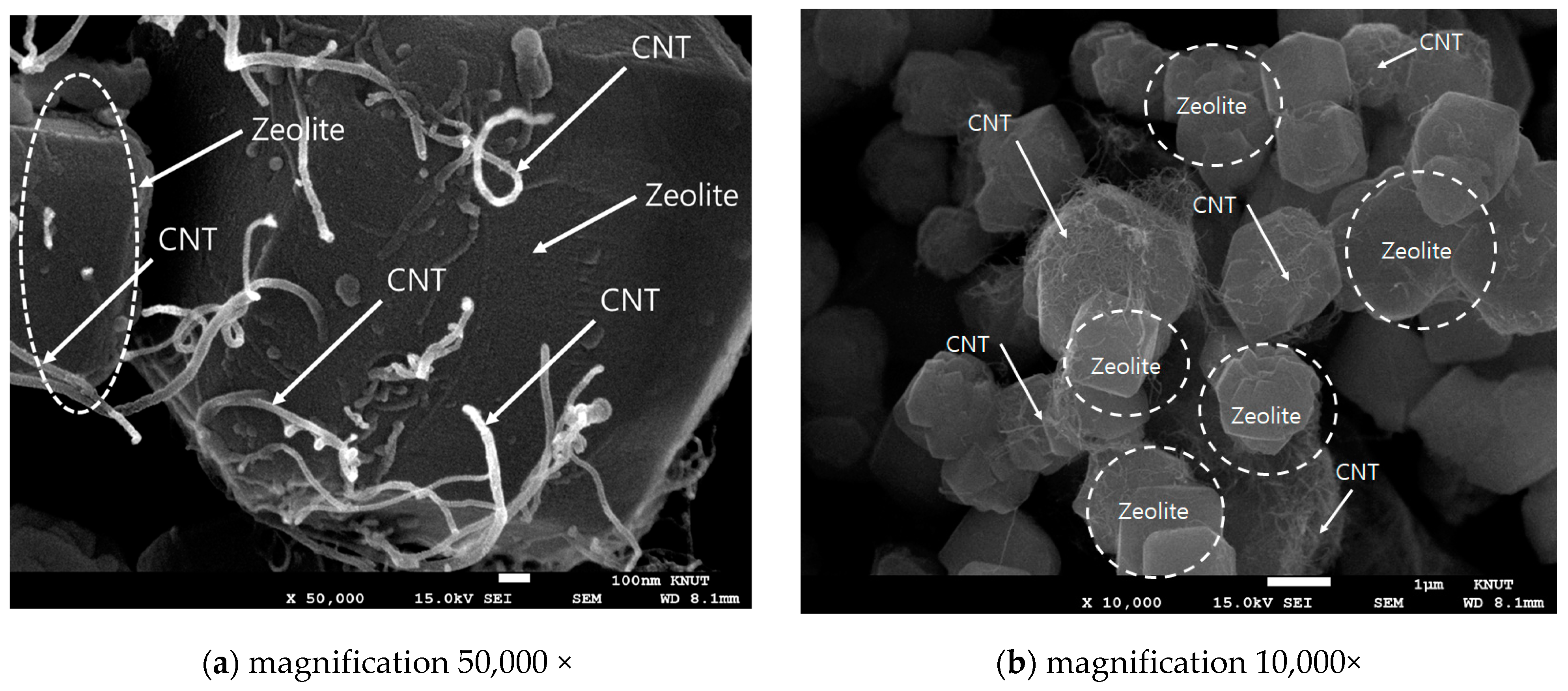

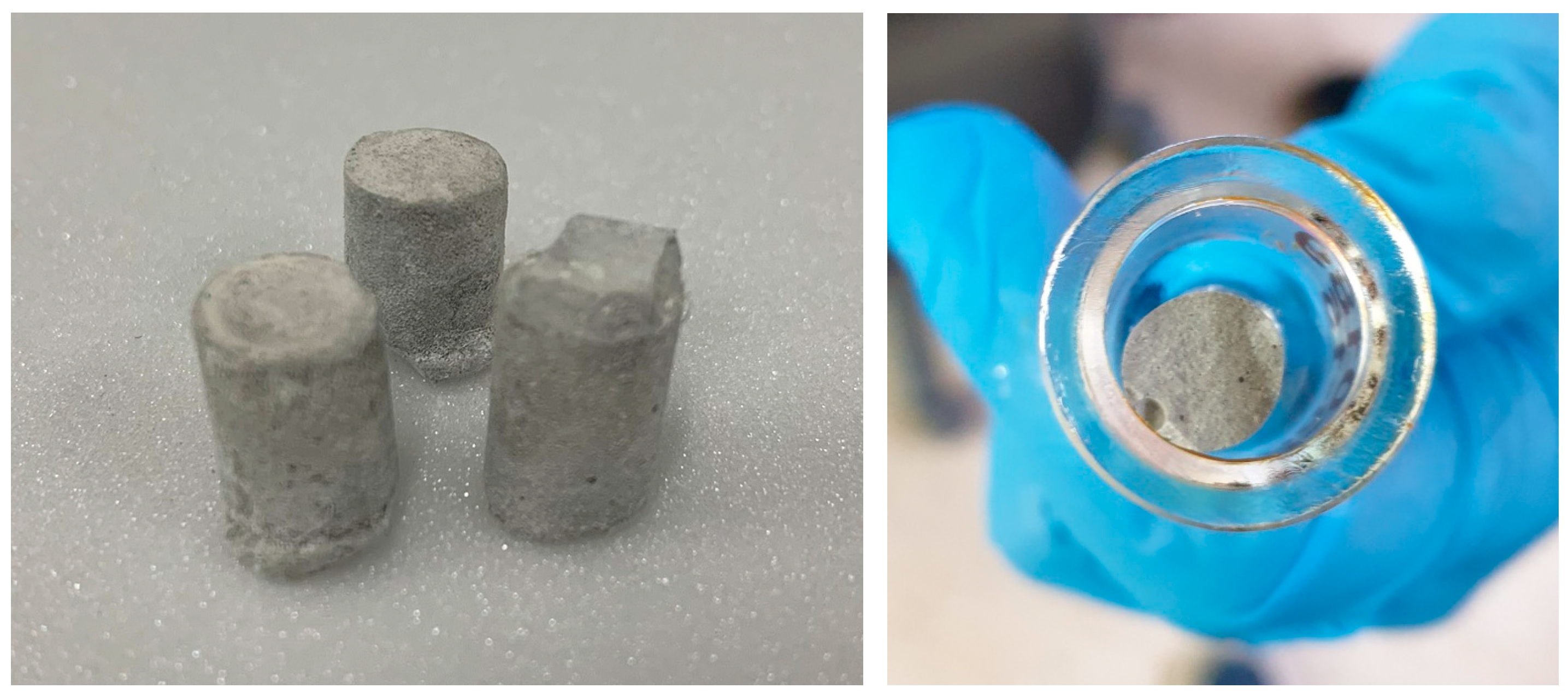
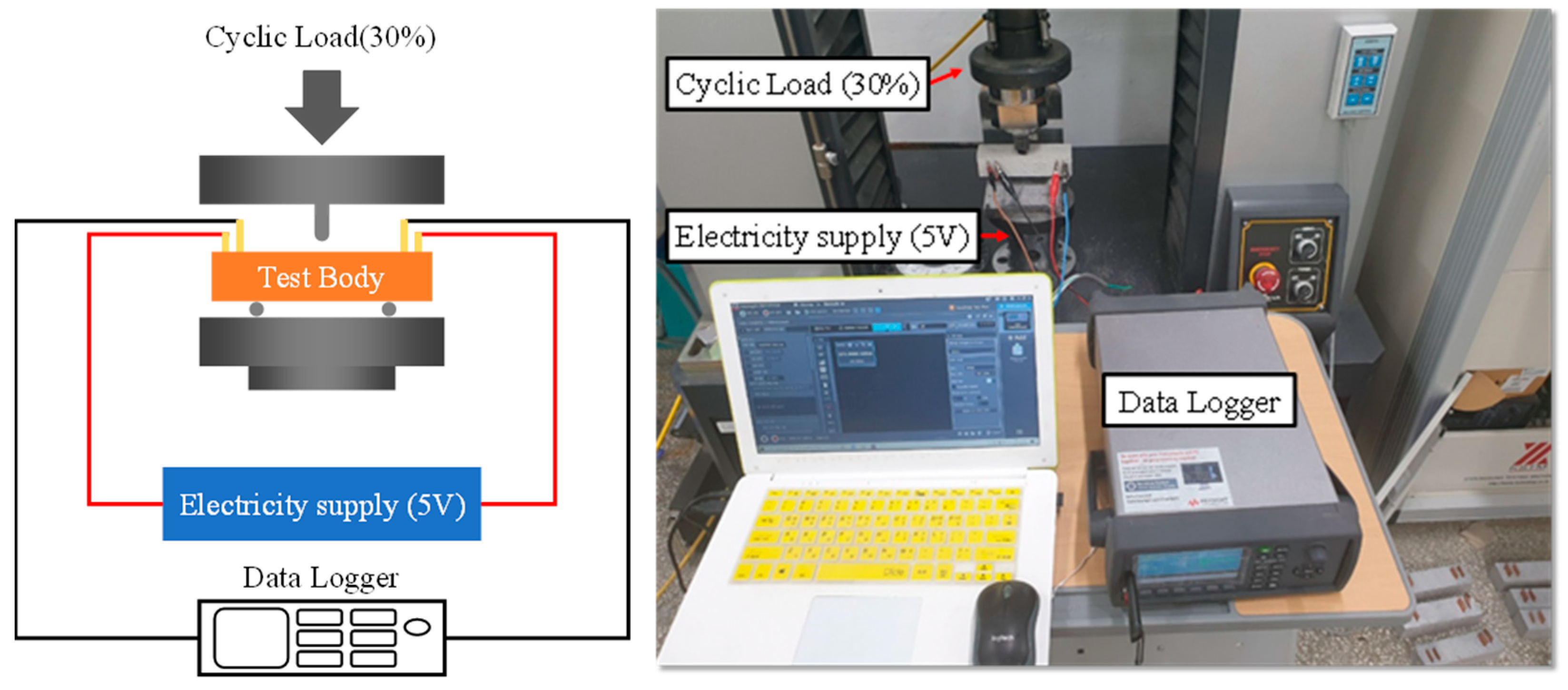
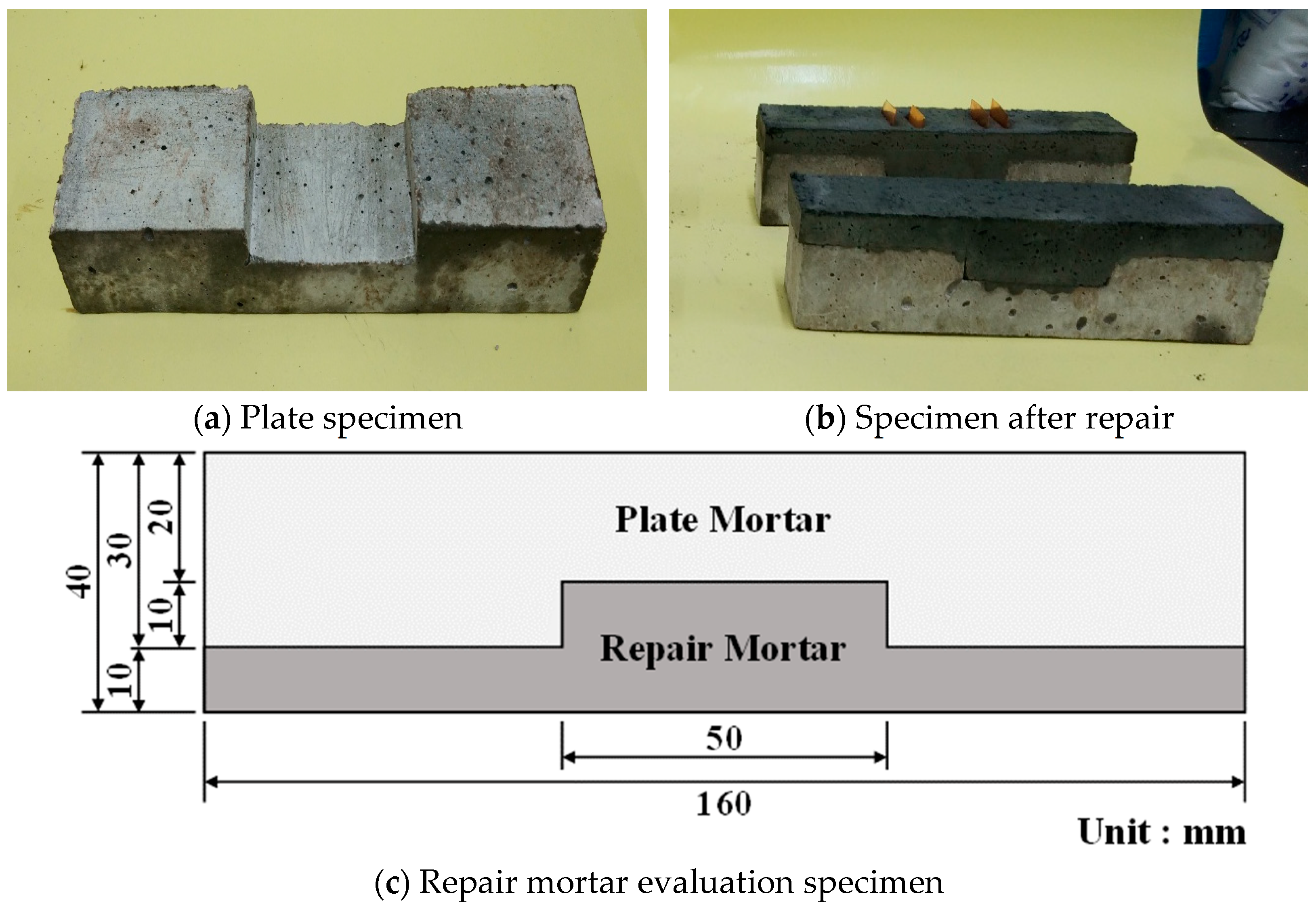
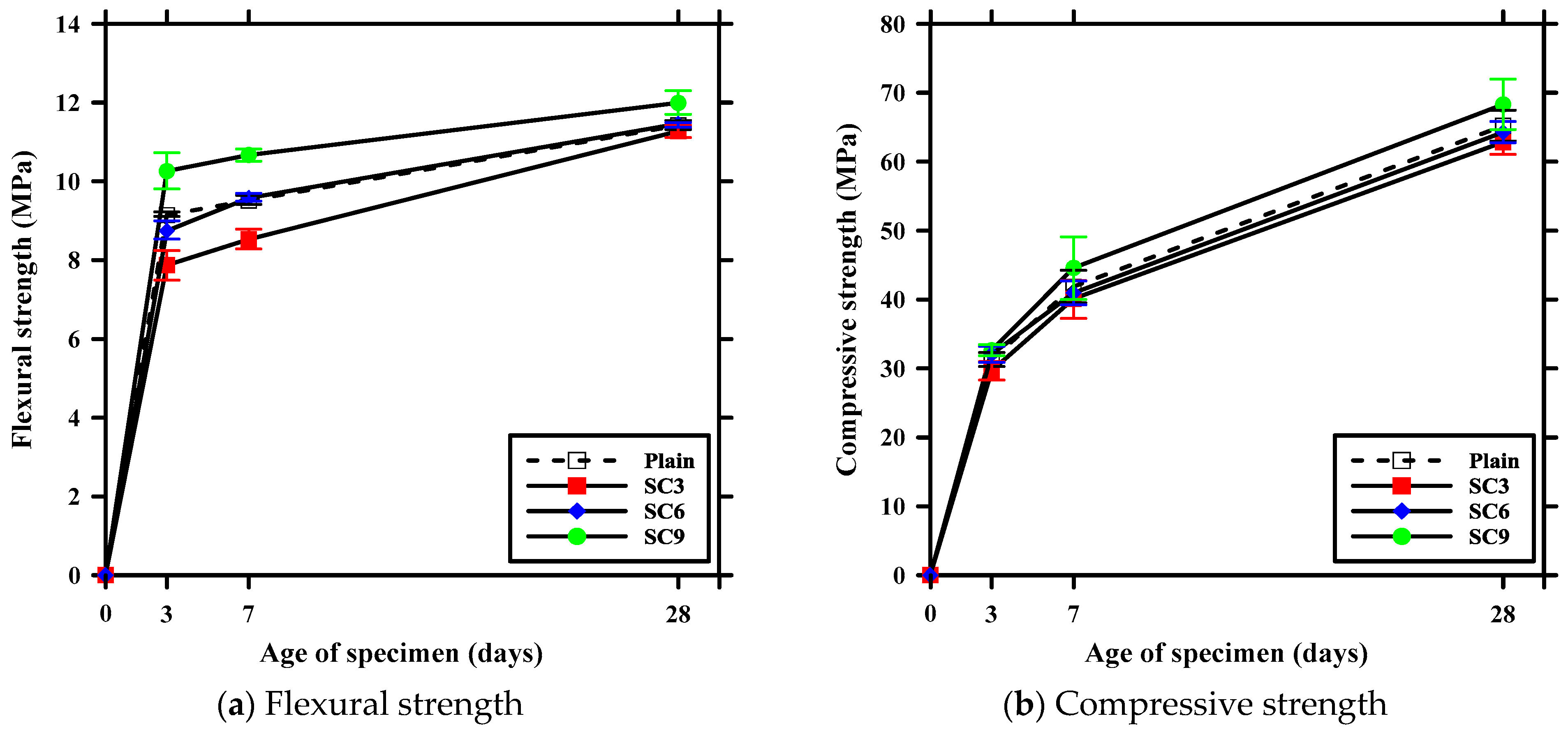
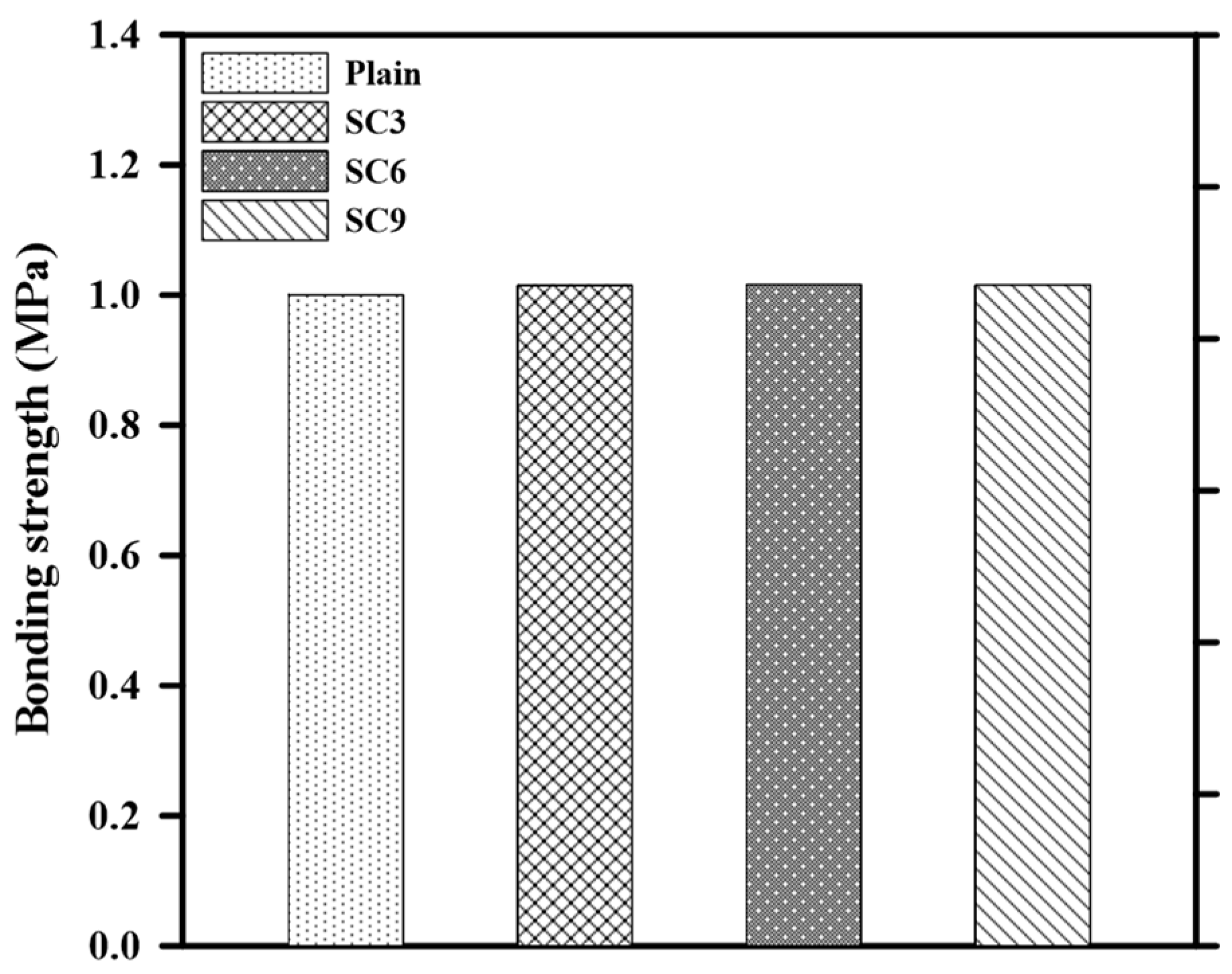
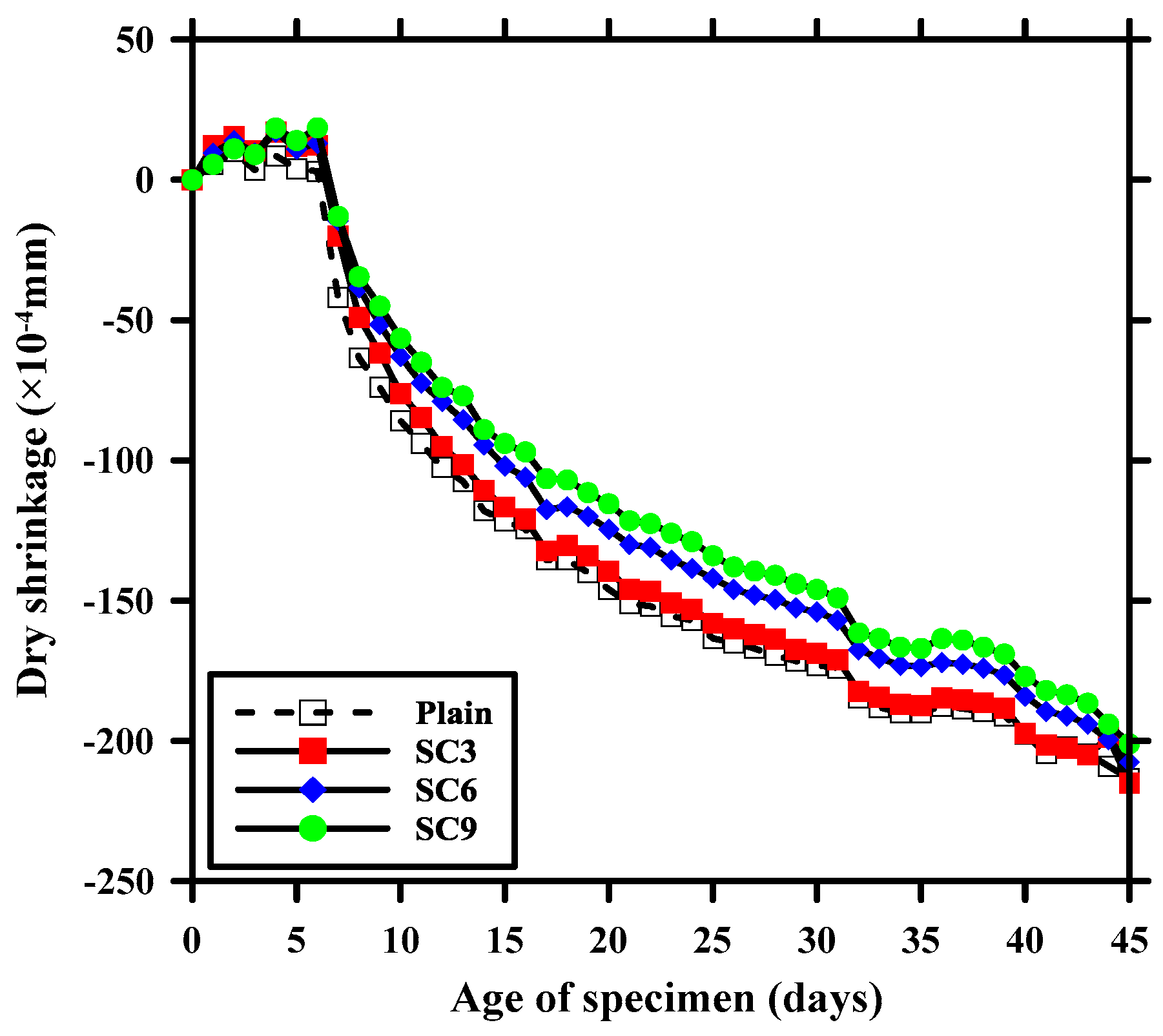



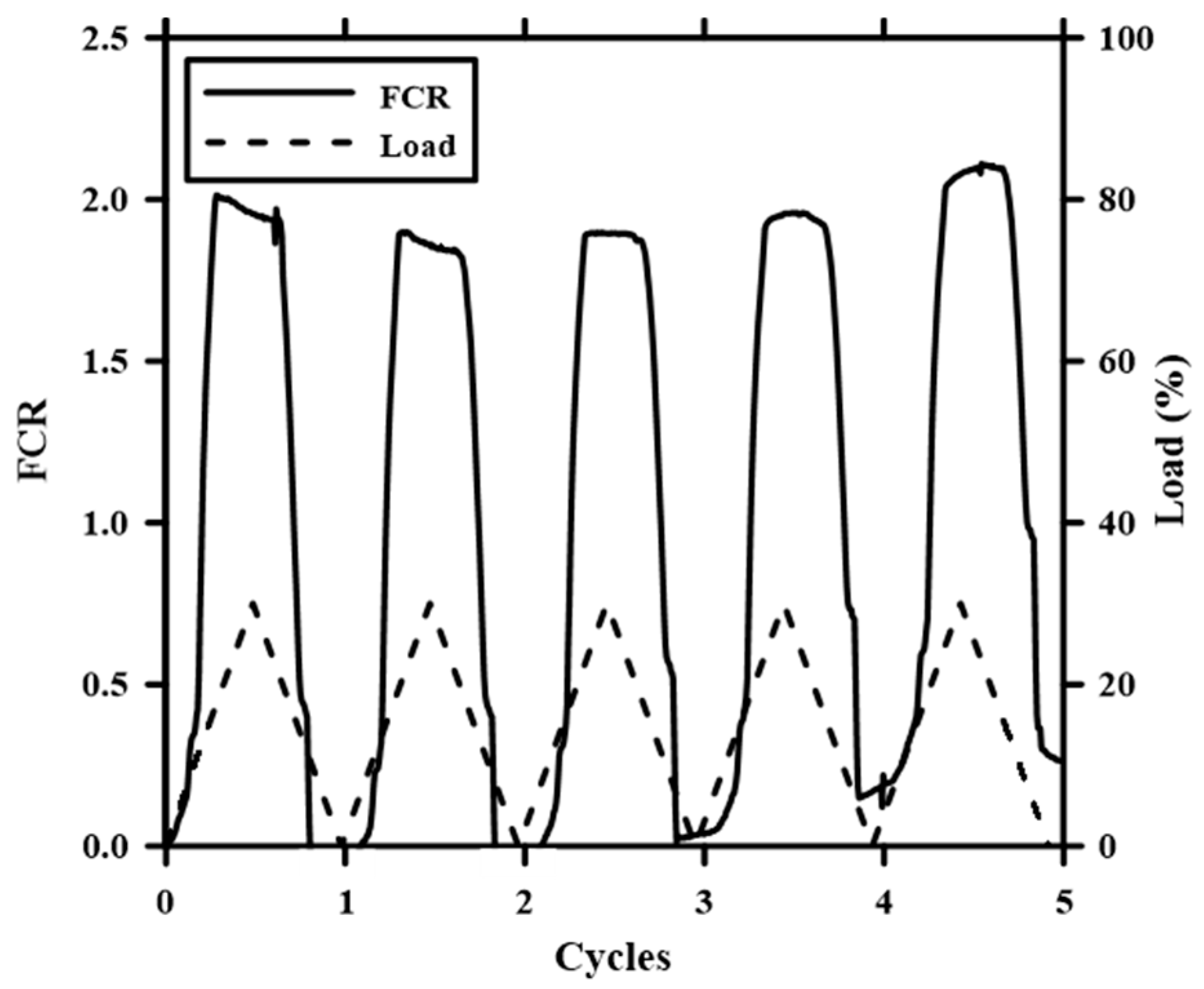
| Chemical Properties (%) | Physical Properties | |||||
|---|---|---|---|---|---|---|
| SiO2 | Al2O3 | Fe2O3 | CaO | MgO | Density (g/cm3) | Fineness (cm2/g) |
| 22.2 | 5.2 | 3.4 | 64.6 | 2.3 | 3.15 | 3300 |
| Item | MWCNT |
|---|---|
| Diameter (nm) | 5~100 |
| Length (μm) | 10 |
| Thermal conductivity (W/m·K) | Max. 3000 |
| Tension (GPa) | <50 |
| Electrical resistance (Ω·m2) | 5.1 × 10−6 |
| Specific surface area (m2/g) | 130~160 |
| Specimen | Silica Sand (%) | S-CNT(%) | ||||
|---|---|---|---|---|---|---|
| 2 mm | 1.8 mm | 0.9 mm | 0.4 mm | 0.15 mm | 0.15 mm | |
| PLAIN | 10 | 10 | 40 | 30 | 10 | 0 |
| SC3 | 7 | 3 | ||||
| SC6 | 4 | 6 | ||||
| SC9 | 1 | 9 | ||||
| Spec | W/B (%) | Binder (%) | Aggregate (%) | Admixture (%) | ||
|---|---|---|---|---|---|---|
| Cement | Polymer | Silica Sand | S-CNT | |||
| Plain | 34 | 96 | 4 | 100 | 0 | 0.1 |
| SC3 | 97 | 3 | ||||
| SC6 | 94 | 6 | ||||
| SC9 | 91 | 9 | ||||
Disclaimer/Publisher’s Note: The statements, opinions and data contained in all publications are solely those of the individual author(s) and contributor(s) and not of MDPI and/or the editor(s). MDPI and/or the editor(s) disclaim responsibility for any injury to people or property resulting from any ideas, methods, instructions or products referred to in the content. |
© 2023 by the authors. Licensee MDPI, Basel, Switzerland. This article is an open access article distributed under the terms and conditions of the Creative Commons Attribution (CC BY) license (https://creativecommons.org/licenses/by/4.0/).
Share and Cite
Kim, Y.; Seo, S.-Y.; Yun, H.-D.; Lee, G.-C.; Hong, S. Development and Investigation of Repair Self-Sensing Composites Using S-CNT. Buildings 2023, 13, 1015. https://doi.org/10.3390/buildings13041015
Kim Y, Seo S-Y, Yun H-D, Lee G-C, Hong S. Development and Investigation of Repair Self-Sensing Composites Using S-CNT. Buildings. 2023; 13(4):1015. https://doi.org/10.3390/buildings13041015
Chicago/Turabian StyleKim, Youngmin, Soo-Yeon Seo, Hyun-Do Yun, Gun-Cheol Lee, and Seongwon Hong. 2023. "Development and Investigation of Repair Self-Sensing Composites Using S-CNT" Buildings 13, no. 4: 1015. https://doi.org/10.3390/buildings13041015
APA StyleKim, Y., Seo, S.-Y., Yun, H.-D., Lee, G.-C., & Hong, S. (2023). Development and Investigation of Repair Self-Sensing Composites Using S-CNT. Buildings, 13(4), 1015. https://doi.org/10.3390/buildings13041015








